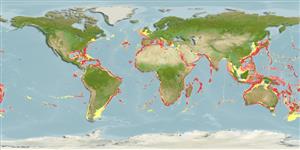Common names from other countries
Environment: milieu / climate zone / depth range / distribution range
Écologie
Benthopélagique; profondeur 60 - 1300 m (Ref. 97594), usually 250 - 750 m (Ref. 409). Tropical; ? - 14°C (Ref. 434), preferred 20°C (Ref. 107945); 55°N - 55°S, 180°W - 180°E
Atlantic, the Mediterranean and Indo-Pacific. Tropical to temperate.
Length at first maturity / Taille / Poids / Âge
Maturity: Lm 3.7, range 3 - 4.414 cm Max length : 17.0 cm TL mâle / non sexé; (Ref. 104052); 22.5 cm TL (female); poids max. publié: 45.90 g (Ref. 126095); poids max. publié: 45.90 g; âge max. reporté: 8 années (Ref. 80203)
Deep-water benthopelagic shrimp (Ref. 114287). Common total length: 12 to 16 cm. Minimum common depth from Ref. 8. Usually caught on muddy and sandy bottoms of continental slopes (Ref. 434).
Life cycle and mating behavior
Maturité | Reproduction | Frai | Œufs | Fécondité | Larves
Spawning occurs during spring to summer. Females have a life span of 7-8 years while males live for 5-6 years.
Pérez Farfante, I. and B. Kensley. 1997. (Ref. 75620)
Statut dans la liste rouge de l'IUCN (Ref. 130435: Version 2024-1)
statut CITES (Ref. 108899)
Not Evaluated
Not Evaluated
Utilisations par l'homme
Pêcheries: commercial
FAO - pêcheries: landings | FishSource | Sea Around Us
Outils
Sources Internet
Estimates based on models
Preferred temperature
(Ref.
115969): 5.9 - 15.7, mean 10 (based on 1552 cells).
Résilience
Haut, temps minimum de doublement de population inférieur à 15 mois (K=0.37-0.96; tm=1.5; tmax=8).
Prior r = 0.77, 95% CL = 0.51 - 1.16, Based on 4 full stock assessments.
Vulnérabilité
Low to moderate vulnerability (27 of 100).
